
Eragrostis is a large and widespread genus of plants in the grass family, found in many countries on all inhabited continents and many islands.

Gloriosa is a genus of 12 species in the plant family Colchicaceae, and includes the formerly recognised genus Littonia. They are native in tropical and southern Africa to Asia, and naturalised in Australia and the Pacific as well as being widely cultivated. The most common English names are flame lily, fire lily, gloriosa lily, glory lily, superb lily, climbing lily, and creeping lily.
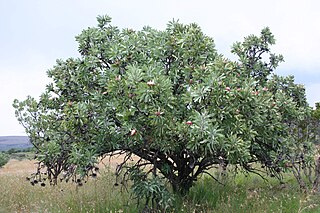
Protea caffra, native to South Africa, is a small tree or shrub which occurs in open or wooded grassland, usually on rocky ridges. Its leaves are leathery and hairless. The flower head is solitary or in clusters of 3 or 4 with the involucral bracts a pale red, pink or cream colour. The fruit is a densely hairy nut. The species is highly variable and has several subspecies.
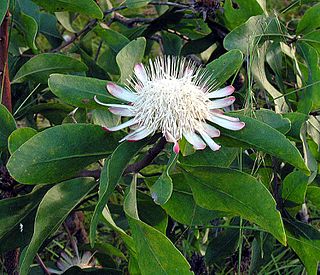
Protea gaguedi is a species of tree which belongs to the genus Protea.

Sporobolus is a nearly cosmopolitan genus of plants in the grass family. The name Sporobolus means "seed-thrower", and is derived from Ancient Greek word σπόρος (spóros), meaning "seed", and the root of βάλλειν (bállein) "to throw", referring to the dispersion of seeds. Members of the genus are usually called dropseeds or sacaton grasses. They are typical prairie and savanna plants, occurring in other types of open habitat in warmer climates. At least one species is threatened with extinction, and another is extinct.

Cyperus eragrostis is a species of sedge known by several common names, including tall flatsedge, nutgrass, tall nutgrass, umbrella sedge, chufa, Earth almond, zula nuts, edible galingale and pale galingale.
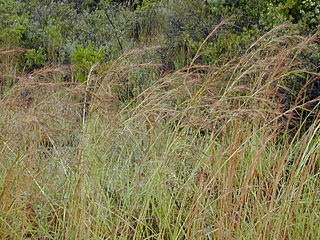
Hyparrhenia is a genus of grasses. Many species are known commonly as thatching grass.

Eragrostis dielsii, commonly known as mallee lovegrass, is a species of grass endemic to Australia.
Pogonarthria is a genus of African plants in the grass family.

Catabrosa is a small but widespread genus of plants in the grass family native to temperate areas of Eurasia, the Americas, and a few places in Africa.
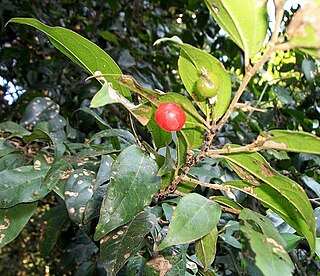
Celtis mildbraedii is a species of forest tree in the family Cannabaceae. It was previously assigned to the family Ulmaceae. These trees grow in limited areas of South Africa, Mozambique and Zimbabwe. They are also found in forested areas from West Africa to Sudan, DRC, Angola and Tanzania. Common names include natal white stinkwood, red-fruited white-stinkwood and natal elm. This species is more common in Tropical Africa than in Southern Africa.

Capparis fascicularis, the zigzag caper-bush, is a plant in the Capparaceae family and is native to Africa.

Erianthemum dregei is a species of parasitic plant in the family Loranthaceae, and is commonly known as the hairy mistletoe or wood flower.
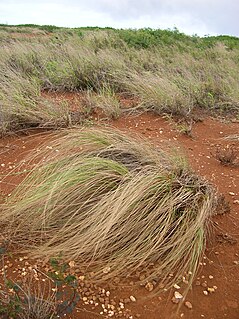
Eragrostis curvula is a species of grass known by the common name weeping lovegrass. Other common names include Boer lovegrass, curved lovegrass, Catalina lovegrass, and African lovegrass.
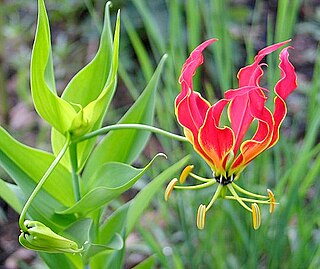
Gloriosa superba is a species of flowering plant in the family Colchicaceae. Common names include flame lily, climbing lily, creeping lily, glory lily, gloriosa lily, tiger claw, agnishikha and fire lily.

Hypolepis sparsisora is an Afrotropical fern species with an extensive range in Africa and Madagascar, where it occurs at diverse altitudes. In South Africa it is present in the Eastern Cape, KwaZulu-Natal, Limpopo, Mpumalanga and the Western Cape.
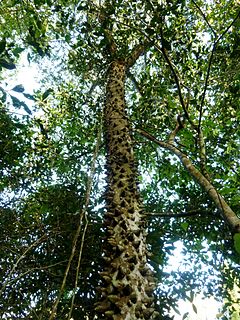
Zanthoxylum davyi, the forest knobwood, is a dioecious species of plant in the family Rutaceae. It is native to the Western Cape, Eastern Cape, KwaZulu-Natal, Mpumalanga and Limpopo provinces of South Africa, western Eswatini and eastern Zimbabwe. It occurs in coastal and mistbelt forests, and grows some 10 to 24 m tall.

Syncolostemon is a genus of plants in the family Lamiaceae, first described in 1838. It is native primarily to South Africa, with some species in other parts of sub-Saharan Africa, plus one species in India.
- Syncolostemon albiflorus(N.E.Br.) D.F.Otieno - Transvaal, Eswatini
- Syncolostemon argenteusN.E.Br. - KwaZulu-Natal
- Syncolostemon bolusii(N.E.Br.) D.F.Otieno - KwaZulu-Natal
- Syncolostemon bracteosus(Benth.) D.F.Otieno - widespread across much of sub-Saharan Africa
- Syncolostemon canescens(Gürke) D.F.Otieno - Angola, Botswana, Zimbabwe, Eswatini, South Africa
- Syncolostemon cinereum(Codd) D.F.Otieno & Retief - South Africa
- Syncolostemon comosus(Wight ex Benth.) D.F.Otieno - southern India
- Syncolostemon comptoniiCodd - Eswatini
- Syncolostemon concinnusN.E.Br. - Eswatini, South Africa
- Syncolostemon densiflorusBenth. - South Africa
- Syncolostemon elliottii(Baker) D.F.Otieno - Zimbabwe, Botswana, Transvaal
- Syncolostemon eriocephalusVerd. - Northern Province of South Africa
- Syncolostemon flabellifolius(S.Moore) A.J.Paton - Chimanimani Mountains of Mozambique + Zimbabwe
- Syncolostemon floccosus(Launert) D.F.Otieno - Namibia
- Syncolostemon foliosus(S.Moore) D.F.Otieno - Eswatini, South Africa
- Syncolostemon gerrardii(N.E.Br.) D.F.Otieno - South Africa
- Syncolostemon incanus(Codd) D.F.Otieno - Northern Province of South Africa
- Syncolostemon latidens(N.E.Br.) Codd - KwaZulu-Natal
- Syncolostemon linearis(Benth.) D.F.Otieno - Zimbabwe
- Syncolostemon macranthus(Gürke) Ashby - Drakensberg Mountains in South Africa
- Syncolostemon macrophyllusGürke - South Africa
- Syncolostemon madagascariensis(A.J.Paton & Hedge) D.F.Otieno - Madagascar
- Syncolostemon modestus(Codd) D.F.Otieno - Eswatini, South Africa
- Syncolostemon namapaensisD.F.Otieno - Mozambique, Tanzania
- Syncolostemon obermeyerae(M.Ashby) D.F.Otieno - Northern Province of South Africa
- Syncolostemon oritrephes(Wild) D.F.Otieno - Chimanimani Mountains of Mozambique + Zimbabwe
- Syncolostemon ornatus(S.Moore) D.F.Otieno - Chimanimani Mountains of Zimbabwe
- Syncolostemon parviflorusE.Mey. ex Benth. - Eswatini, South Africa
- Syncolostemon parvifolius(Codd) D.F.Otieno - Northern Province of South Africa
- Syncolostemon persimilis(N.E.Br.) D.F.Otieno - Northern Province of South Africa
- Syncolostemon petiolatus(Ashby) D.F.Otieno - Eswatini, South Africa, Mozambique
- Syncolostemon pretoriae(Gürke) D.F.Otieno - Eswatini, South Africa
- Syncolostemon punctatus(Codd) D.F.Otieno - Northern Province of South Africa
- Syncolostemon ramosus(Codd) D.F.Otieno - KwaZulu-Natal
- Syncolostemon ramulosusE.Mey. ex Benth. - KwaZulu-Natal, Cape Province
- Syncolostemon rehmannii(Gürke) D.F.Otieno - Northern Province of South Africa
- Syncolostemon rotundifoliusE.Mey. ex Benth. - KwaZulu-Natal, Cape Province
- Syncolostemon rugosifolius(M.Ashby) D.F.Otieno - Northern Province of South Africa
- Syncolostemon stalmansii(A.J.Paton & K.Balkwill) D.F.Otieno - Mpumalanga, Eswatini
- Syncolostemon stenophyllus(Gürke) D.F.Otieno - KwaZulu-Natal, Cape Province
- Syncolostemon subvelutinus(Gürke) D.F.Otieno - Northern Province of South Africa
- Syncolostemon teucriifolius(Hochst.) D.F.Otieno - Mozambique, Zimbabwe, South Africa
- Syncolostemon thorncroftii(N.E.Br.) D.F.Otieno - Northern Province of South Africa
- Syncolostemon transvaalensis(Schltr.) D.F.Otieno - Northern Province of South Africa
- Syncolostemon welwitschii(Rolfe) D.F.Otieno - Nigeria, Cameroon, Central African Republic, Zaire, Tanzania, Zambia, Angola

Protea dracomontana, the Nyanga protea or the Drakensberg sugarbush, is a flowering plant that belongs within the genus Protea. The plant is found in the Eastern Cape, Lesotho, KwaZulu-Natal and the escarpment of the Free State, as well as eastern Zimbabwe. In Zimbabwe this species is only known from a disjunct subpopulation confined to the summit of Mount Nyangani.


















